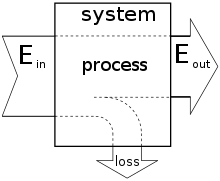
A | B | C | D | E | F | G | H | CH | I | J | K | L | M | N | O | P | Q | R | S | T | U | V | W | X | Y | Z | 0 | 1 | 2 | 3 | 4 | 5 | 6 | 7 | 8 | 9
| Thermodynamics |
|---|
 |
In thermodynamics, the thermal efficiency () is a dimensionless performance measure of a device that uses thermal energy, such as an internal combustion engine, steam turbine, steam engine, boiler, furnace, refrigerator, ACs etc.
For a heat engine, thermal efficiency is the ratio of the net work output to the heat input; in the case of a heat pump, thermal efficiency (known as the coefficient of performance) is the ratio of net heat output (for heating), or the net heat removed (for cooling) to the energy input (external work). The efficiency of a heat engine is fractional as the output is always less than the input while the COP of a heat pump is more than 1. These values are further restricted by the Carnot theorem.
Overview

In general, energy conversion efficiency is the ratio between the useful output of a device and the input, in energy terms. For thermal efficiency, the input, , to the device is heat, or the heat-content of a fuel that is consumed. The desired output is mechanical work, , or heat, , or possibly both. Because the input heat normally has a real financial cost, a memorable, generic definition of thermal efficiency is[1]
From the first law of thermodynamics, the energy output cannot exceed the input, and by the second law of thermodynamics it cannot be equal in a non-ideal process, so
When expressed as a percentage, the thermal efficiency must be between 0% and 100%. Efficiency must be less than 100% because there are inefficiencies such as friction and heat loss that convert the energy into alternative forms. For example, a typical gasoline automobile engine operates at around 25% efficiency, and a large coal-fuelled electrical generating plant peaks at about 46%. However, advances in Formula 1 motorsport regulations have pushed teams to develop highly efficient power units which peak around 45–50% thermal efficiency. The largest diesel engine in the world peaks at 51.7%. In a combined cycle plant, thermal efficiencies approach 60%.[2] Such a real-world value may be used as a figure of merit for the device.
For engines where a fuel is burned, there are two types of thermal efficiency: indicated thermal efficiency and brake thermal efficiency.[3] This form of efficiency is only appropriate when comparing similar types or similar devices.
For other systems, the specifics of the calculations of efficiency vary, but the non-dimensional input is still the same:
Efficiency = Output energy / input energy.
Heat engines

Heat engines transform thermal energy, or heat, Qin into mechanical energy, or work, Wout. They cannot do this task perfectly, so some of the input heat energy is not converted into work, but is dissipated as waste heat Qout < 0 into the surroundings:
The thermal efficiency of a heat engine is the percentage of heat energy that is transformed into work. Thermal efficiency is defined as
The efficiency of even the best heat engines is low; usually below 50% and often far below. So the energy lost to the environment by heat engines is a major waste of energy resources. Since a large fraction of the fuels produced worldwide go to powering heat engines, perhaps up to half of the useful energy produced worldwide is wasted in engine inefficiency, although modern cogeneration, combined cycle and energy recycling schemes are beginning to use this heat for other purposes. This inefficiency can be attributed to three causes. There is an overall theoretical limit to the efficiency of any heat engine due to temperature, called the Carnot efficiency. Second, specific types of engines have lower limits on their efficiency due to the inherent irreversibility of the engine cycle they use. Thirdly, the nonideal behavior of real engines, such as mechanical friction and losses in the combustion process causes further efficiency losses.
Carnot efficiency
The second law of thermodynamics puts a fundamental limit on the thermal efficiency of all heat engines. Even an ideal, frictionless engine can't convert anywhere near 100% of its input heat into work. The limiting factors are the temperature at which the heat enters the engine, , and the temperature of the environment into which the engine exhausts its waste heat, , measured in an absolute scale, such as the Kelvin or Rankine scale. From Carnot's theorem, for any engine working between these two temperatures:[4]
Antropológia
Aplikované vedy
Bibliometria
Dejiny vedy
Encyklopédie
Filozofia vedy
Forenzné vedy
Humanitné vedy
Knižničná veda
Kryogenika
Kryptológia
Kulturológia
Literárna veda
Medzidisciplinárne oblasti
Metódy kvantitatívnej analýzy
Metavedy
Metodika
Text je dostupný za podmienok Creative
Commons Attribution/Share-Alike License 3.0 Unported; prípadne za ďalších
podmienok.
Podrobnejšie informácie nájdete na stránke Podmienky
použitia.
www.astronomia.sk | www.biologia.sk | www.botanika.sk | www.dejiny.sk | www.economy.sk | www.elektrotechnika.sk | www.estetika.sk | www.farmakologia.sk | www.filozofia.sk | Fyzika | www.futurologia.sk | www.genetika.sk | www.chemia.sk | www.lingvistika.sk | www.politologia.sk | www.psychologia.sk | www.sexuologia.sk | www.sociologia.sk | www.veda.sk I www.zoologia.sk

























